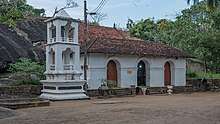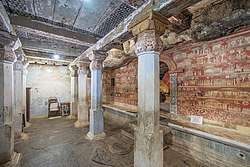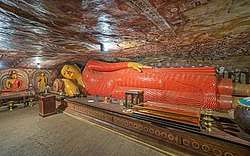Degaldoruwa Raja Maha Vihara
Degaldoruwa Raja Maha Vihara (Sinhala: දෙගල්දෝරුව රජමහා විහාරය) is an ancient Buddhist rock temple, situated in Amunugama, Kandy, Sri Lanka. It is famous for its Kandyan Era Frescoes.[1][2] The cave itself was said to have been excavated out of a rock which rises to a height of approximately 12.3 m (40 ft),[3] and shelters the shrine room and entrance chamber.
| Degaldoruwa Raja Maha Vihara | |
|---|---|
දෙගල්දෝරුව රජමහා විහාරය | |
 | |
| Religion | |
| Affiliation | Buddhism |
| District | Kandy |
| Province | Central Province |
| Location | |
| Location | Kandy, Sri Lanka |
| Geographic coordinates | 07°18′16″N 80°39′50″E |
| Architecture | |
| Type | Buddhist Temple |
| Founder | King Rajadhi Rajasinha |
| Completed | 1771 AD |


Details relating to the construction of the temple and the royal land grant are contained on the Degaldoruwa Tamba Sannasa (Copper Plate).[4][3] Construction of the temple was commenced in 1771 during the reign of King Kirti Sri Rajasinha [1747-1782 AD][5] by his younger brother, Rajadhi Rajasinha and completed by Rajadhi Rajasinha after he ascended to the throne.[4] Following the temples completion Rajadhi Rajasinghe placed the Temple in the custody of a learned monk, Moratota Dhammakkanda Maha Nayaka Thera [1734-1811], who was also Rajadhi Rajasingha's teacher and chief advisor.
History
Local folklore details that the origins of the temple relate to a time when a farmer investigated a gap between two large boulders near his village and discovered a pile of golden sickles. The farmer then too one of the sickles and used it to harvest his crops, replacing it in the evening when he returned home. He continued to do this every morning, each time returning the sickle at the end of the day.
On the final day of harvesting the farmer took two sickles however in the evening he only replaced one of the sickles back on the pile. The treasure's guardian upon discovering that one of the sickles was missing confronted the farmer and demanded he return it immediately. The terrified farmer ran back to his fields and recovered the sickle placing it back into the gap between the boulders. The guardian then sealed the opening by fusing the two boulders together.
The other members of the village became aware of this event and informed the King Kirti Sri Rajasinha, who instructed them to clear the cave and erect a temple there.[6]
Structures
The temple is hollowed out of a large 12.3 m (40 ft) rock outcrop and consists of an elegant rock shelter with two roofed ante chambers in front, the first one a drumming hall and the second an image house, both of which are constructed outside the rock outcrop and topped by wooden roofs, whilst the third chamber, the main shrine room, is cut into the rock itself.
- Drumming hall
The drumming hall (or digge) is unusual in that it is directly attached to the rest of the temple, rather than occupying a separate pavilion as is typically found in most similar temples.
- Image house
The image house (or Budu-ge) is located through a set of old wooden doors, situated under a carved wooden Makara Torana (or Dragon Arch) lead into the antechamber, which preserves a moonstone and a sequence of paintings showing scenes from four Jātaka tales (stories that tell about the previous 550 lives of the Buddha, in both human and animal form), Vessantara Jātaka,[7] Sattubhatta Jātaka, Sutasoma Jātaka and Mahaseelava Jātaka[6] painted in five vivid panels.[8]
- Shrine room
The doors leading from here into the main shrine have metal fittings which were formerly studded with jewels. The principal image is a large reclining Buddha; the wall opposite the reclining Buddha is painted with scenes from the previous birth of Buddha together with pictures of stupas at Sri Lanka's principal pilgrimage sites.
- Murals
Four ‘Sittara’ artists are credited with painting the Degaldoruwa murals, Nilagama Patabanda (the chief layman of Balavatvala), Devaragampola Silvatänna[4] (an unordained monk, who also painted murals at Ridi Viharaya), Kosvatte Hiriyale Naide and Devendra Mulachari.[8][9] The finest painting is on the ceiling, ‘Mara Yudde’, an artistic depiction of Buddha's internal spiritual battle against Māra, the demon of death, rebirth and desire. The murals are unique in that all the various elements – the people, the trees and the animals are a uniform size and it is only the front view of individual people that is shown, not the rear view. The trees are painted in a stylised form, with their branches and leaves spreading out to each side. The individual elements are portrayed in great detail, such as the adornments on the elephants and the uniforms of the attendants. All of the colours used by the artists in the murals were sourced from the bark of nearby trees.[10]
See also
- List of Archaeological Protected Monuments in Sri Lanka
| Wikimedia Commons has media related to Degaldoruwa Raja Maha Vihara. |
References
- De Silva, K. M. (1981). A History of Sri Lanka. University of California Press. pp. 208-209. ISBN 9780520043206.
- Koḷamba Taruṇa Bauddha Saṅgamaya (1988). "The Buddhist". 59. Colombo Young Men's Buddhist Association: 11. Cite journal requires
|journal=(help) - "Degaldoruwa - The Cave Temple in Kandy with famous Wall Paintings". SriLankaView. Retrieved 23 November 2016.
- Seneviratna, Anuradha; Polk, Benjamin (1992). Buddhist Monastic Architecture in Sri Lanka: The Woodland Shrines. Abhinav Publications. p. 126. ISBN 9788170172819.
- Gunawardena, Charles A. (2005). Encyclopedia of Sri Lanka. Sterling Publishers Pvt. Ltd. p. 303. ISBN 9781932705485.
- "Degaldoruwa Raja Maha Vihara – දෙගල්දෝරුව රජමහා විහාරය". Amazing Lanka. Retrieved 23 November 2016.
- Bode, Mabel Haynes (1912). The Mahāvaṃsa: Or, The Great Chronicle of Ceylon. Pali Text Society. p. 206.
- Holt, John Clifford (1996). The Religious World of Kirti Sri: Buddhism, Art, and Politics of Late Medieval Sri Lanka. Oxford University Press. pp. 51–51. ISBN 9780195355420.
- Pieris, Kamalika (5 June 2015). "Some official documents of the Udarata Kingdom". The Island. Retrieved 18 November 2016.
- "Degaldoruwa – The Cave Temple". ToursLanka vacations Ltd. Retrieved 24 November 2016.
Further reading
- Disanayaka, J. B.; Ilukkumbure, Janaka (Ill). Golden Sickles of Degaldoruwa. Nugegoda: Sumitha Books.
- Agrawal, Om Prakash; Wickramasinghe, Nanda Amara (2012). Materials & Techniques of Ancient Wall Paintings of Sri Lanka. Indian National Trust for Art and Cultural Heritage. ISBN 9788175741287.